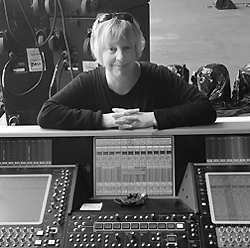
Keyes explained to Rat that she wanted to learn about what he did. Her first lesson was wrapping microphone cables, she adds. After a subsequent gig in Palo Alto, she returned home certain of her future career.
“That experience highlights what I tell people starting out: seize opportunities. I was in the right place at the right time. I couldn’t walk into Rat Sound now and say, ‘I want to learn how to do sound.’ At that time, however, the company was a couple of people doing punk rock shows who said, ‘Sure, come help. We need help,’” she notes, laughing.
Prior to that, the 17-year-old Keyes was working a part-time retail job and taking just enough classes at a local community college to make her parents happy. “I had no clear career path; it was, maybe writing, maybe something else, or maybe I’m not going to school today,” she says.
Although she didn’t take her classes too seriously then, her perspective on it now is offered as advice to others: “Go to school until you figure out what you want to do, if you can. It’s going to benefit you down the road, somehow.”
Personally and professionally, Rat and Keyes made a good match, and soon the two became a couple, working shows together and living in a warehouse – without hot water – for two years until building up enough work/income to afford to live elsewhere. “Until then every dime went back into the systems, insurance, or gas,” Keyes says.
“We were together for 10 years,” she continues, “and we raised two amazing daughters – now 20 years old – while working in this crazy industry. We actually decided to split up when I was pregnant, realizing our relationship wouldn’t last. And it’s impressive, looking back, that we could make that decision calmly and rationally, and we’ve co-parented the girls ever since.”
Learning The Craft
Doing so while managing conflicting touring schedules wasn’t always easy, but, as one of relatively few women in audio, Keyes is no stranger to challenge. Early on at Rat Sound, she did whatever needed doing – loading and unloading trucks, working every show she could, learning the gear, the craft and how to troubleshoot. The pay was minimal, but the experience integral to her career.
Some jobs were a bit daunting, she notes, adding, “But it’s all relative. The less experience you have, the scarier the gig. At least they should be. I’ve seen people who say, ‘I’ve got this, no problem.’ And I’m watching them, thinking, ‘You don’t have this. Slow down, ask for help, and people will help. You should have some apprehension if you don’t have experience.”
One of Keyes’ first regular gigs was with The Untouchables, as system tech for their Southern California gigs. Later, when Rat, then the band’s monitor engineer, moved to FOH, Keyes took over on monitors through to 1990.
She continued working with Rat Sound for 20 years, finally leaving in 2005 to focus her efforts exclusively on touring and live sound. “I did the books for years and paid the bills because I was better at that than in the shop with a table saw,” she explains. “The last five years I mainly did human resources and management, but that wasn’t what I wanted to do.”
Stage Matters
Although Keyes has occasionally mixed FOH, her preference is monitors. Beyond being able to mix quickly, learn from your mistakes and consistently improve your chops, it’s important, when mixing for the pickiest listeners in the room, she says, to realize that you’re providing a service.
One of the most important things for a monitor engineer to understand, Keyes insists, is to know when to do nothing: “With Pearl Jam there are set cues, and once the rig is up and running there shouldn’t be a lot of changes. If there are, something’s wrong.”
